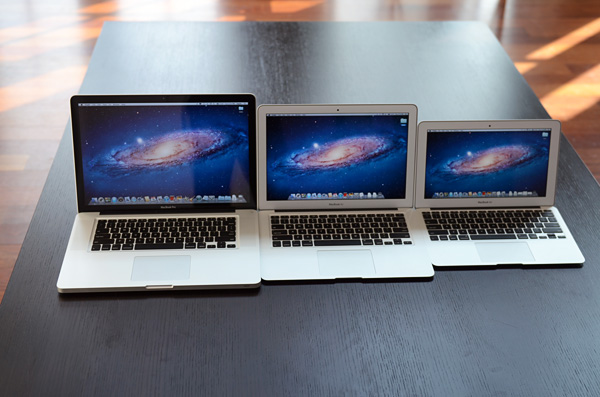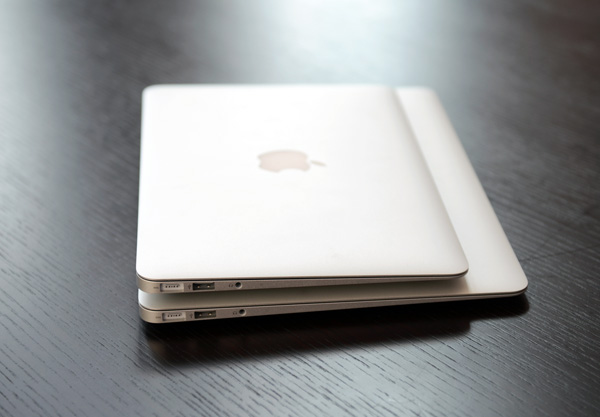The 2011 MacBook Air (11 & 13-inch): Thoroughly Reviewed
by Anand Lal Shimpi on July 28, 2011 3:25 AM EST- Posted in
- Apple
- Mac
- Intel
- Sandy Bridge
- MacBook Air
- Laptops
Final Words
Whereas last year's MacBook Air was a good machine for light work, the 2011 models are true replacements for mainstream portable Macs. There's still no dethroning the MacBook Pro (although the 13-inch model clearly needs a higher resolution display option), but for the rest of the world there are now some excellent ultra portable options that don't force you to really compromise on performance.
Both the 11 and 13-inch MacBook Air are fast enough to replace your 3 year old MacBook Pro and still deliver better performance. You can even move from a 2010 MacBook Pro to an upgraded MacBook Air and not notice any drop in performance. All of this is thanks to Intel's Sandy Bridge CPU.

From left to right: 15-inch MacBook Pro, 13-inch MacBook Air, 11-inch MacBook Air
It's the GPU performance that I'm less excited about. While last year's GeForce 320M isn't significantly faster than the HD 3000 in the new MacBook Air, it's still faster in our tests. There's not much Apple could've done about this. I don't believe a discrete GPU in an Air makes sense, but this should be a clear message to Intel. Sandy Bridge's GPU is the bare minimum, we need to really see a real ramp in performance from here on out. Ivy Bridge will give us a bit of that but not another doubling in GPU performance. Perhaps we'll see something significant from Haswell in 2013. For now, if you like gaming on the go you'll have to get a MacBook Pro.
When it comes to battery life the new MacBook Air doesn't break any records, but it doesn't disappoint either (at least under OS X). With the exception of the our light web browsing test, the new MacBook Air behaves pretty similarly to last year's model on battery power. The new 13 doesn't do anywhere near as well in mostly idle scenarios but under moderate to heavy load the new MBAs last at least as long as their predecessors.
The only move I would be careful about is a downgrade from a 13-inch 2011 MacBook Pro. The new 13-inch MBP is still considerably faster than the MacBook Air, while the more portable form factor is tempting you're better off waiting to see what Apple does with the next update to the MacBook Pro.
If you were a fan of the original MacBook Air, the 2011 models are just as significant of an introduction as the very first one in 2008. They may not look any different from the outside, but the new 11 and 13-inch MacBook Air are a significant step forward. These systems are no longer niche ultraportables, they've instead brought the ultraportable niche into the mainstream.
If you're stuck deciding between the two I think it breaks down like this. If you've got a beefy system at home and just need something portable for travel, the 11-inch Air is perfect. It's now fast enough to get real work done on the road and portable enough to feel like a tablet with an integrated keyboard. If you're replacing a primary notebook however, the 13 is the safer bet. It is sized like a normal notebook, you get longer battery life and a bigger screen to look at. If you're a fan of extremes, the 11 is for you. If you like balanced compromises, go with the 13.
What happens from here on out is what's really interesting. Intel has already committed to moving the TDP of its mainstream parts from 35W - 45W down to 10 - 20W. Since the Air is the new mainstream Mac notebook, Apple has already made that move. The performance in this 10 - 20W segment is going to get much better over the next two years, particularly once Haswell arrives.
The Thunderbolt Display is the first sign of what's to come. Moving IO controllers and expansion into the display, and potentially even moving discrete GPUs out of the notebook are all in store for us. Apple is really ahead of the curve here, but it's easy to imagine a future where laptops become a lot more like the new Air and shift to a couple high bandwidth ports instead of numerous lower bandwidth connections.
There's a lot to like with the new MacBook Airs; the last update was good, but performance was still often lacking. The MBA 11 in particular is now much more useful, and the 13 rightfully spells the end of the line for the old MacBook. While pricing is higher than typical 11" to 13" Windows laptops, you really can't find a competing Windows laptop with all the features the MBA offers without paying a similar price premium. You get a nice chassis with excellent build quality, decent displays that trump every budget laptop we've looked at, and reasonable battery life. If you like thin and light ultraportables, the MacBook Air continues to be one of the best options around.











103 Comments
View All Comments
mschira - Friday, July 29, 2011 - link
well you are not thinking apple enough for this. saving 100$ is no reason accepting a mess on your table...besides who sais you need to toss the display when the gfx is outdated? what's keeping you from connecting the display via A dedicated GPU box once the internal GPU becomes to slow?
M.
darwinosx - Saturday, July 30, 2011 - link
In the display? So when the card is obsolete you get a new display? How about outside the laptop and the display but in between both.AJ Driver - Thursday, July 28, 2011 - link
Thanks Anand :)The irony for me reading your review and others around the internet is the comparison in performance between these MBAs and other models (both new and old).
My personal laptop is a 5, going on 6, year old Macbook and for what I use it for it's more than good enough. It's pretty incredible the way technology is advancing, and if the current pc stays the course I wait as long as I can before taking the leap.
It's hard to deny the urge to upgrade though!
Marand - Thursday, July 28, 2011 - link
Well I thought I was finally clear that I was going to buy a MacBook Pro 13 but now I am not so sure.I mainly use my laptop for software development. My previous one was MacBook pro 2007 model which served me well.
My issue with the pro line is that because of their weight, it just ends up becoming a desktop that I don't take with with me and always plugged into a large screen.
But having the ability to put 8 gigs of ram and update the hard drive on the new MBPro is a nice option to have.
I really hoped that apple was going to release MBAs with 8 gigs of ram at least and even if you can't upgrade the hard drive (although I heard you can with prev gen from OWC) you could always plug in bigger drives through thunderbolt if and when drives comes out.
The big selling factor for the MBA for me was the weight. I figured it would be super easy to take with me where and when I want without treating it like a desktop.
I know the MBAs are not targeted to developers. Ut I know plenty who were hoping for "more" from MBA
So now I have a tough choice because the MBpro 15 with quad core and the hi res anti glare screen is packed with power even if it's heavier and likely has more long term capability.
Oh well, can't have it all I guess...
A5 - Thursday, July 28, 2011 - link
If the 15" MBP is too heavy for you, you may want to get a more supportive bag or something. I would've killed for a 5.6lb 15" laptop 8 years ago :PUritziel - Thursday, July 28, 2011 - link
Remember, you're not supposed to carry it around attached to your ear lobe :)I carried a 17-inch DTR laptop that weighed about 10 lbs. around campus for a year, so 5.6 lbs. sounds light to me too. I consider battery life as the main metric of portability after weight hits that 5 lbs. mark.
crimson117 - Thursday, July 28, 2011 - link
>The only exception is if you're just going to spend your time doing very basic tasks on the machine and plan on upgrading again in a year or two. If that's the case save your money and enjoy a 4GB version with Ivy Bridge next year.People who can afford a new MacBook Air every time a new one comes out aren't going to be worried about saving their money on a ram upgrade :)
steven75 - Thursday, July 28, 2011 - link
Apple hardware has incredible resale value, so it's actually easier to do than you think.Uritziel - Thursday, July 28, 2011 - link
Don't forget that if you buy a laptop for $2000 today and sell it at that great Apple resale value of say $1000 (numbers are random) in a few years when you're ready to upgrade, the laptop did NOT cost $1000 in the end.Adding on the effort required to resell it, that rationale makes a lot less sense than some people claim.
Rasterman - Wednesday, August 3, 2011 - link
I'm looking at upgrading right now so I looked up the resale value of mine. I bought a new MB for $1150 in 2008, used prices are $500-$800 right now, I expect to sell mine north of $700 since it is in brand new condition as I only used it as a dev machine when porting and it has seen very little use. So my expected resale value is 61% after 3 years which is pretty damn good IMO.